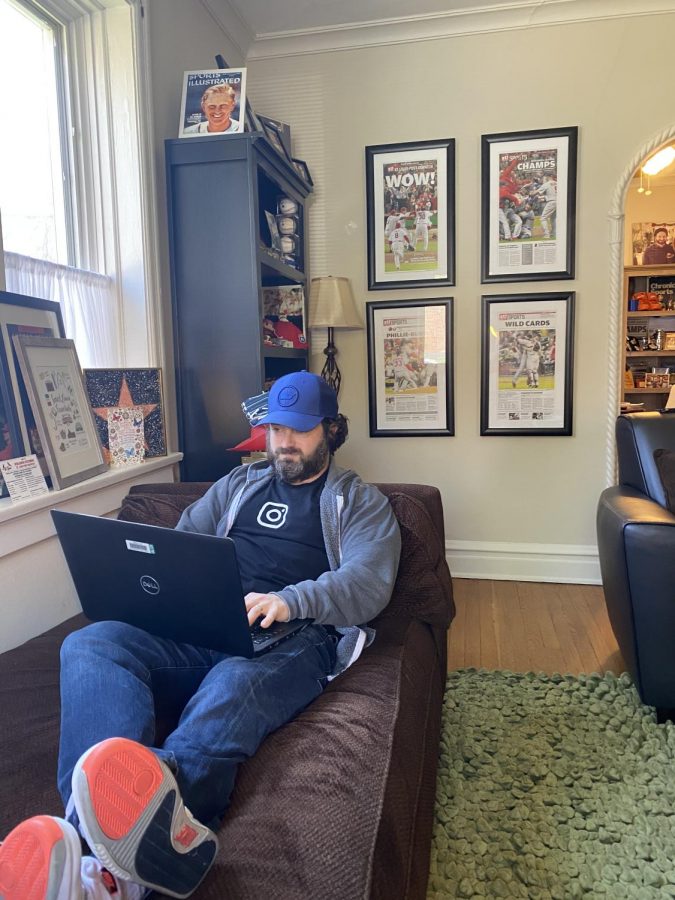Every night at 7 p.m, New York Times Senior Staff Editor Tom Gaffney steps out of the doorway of his house in Manhattan and listens to his neighbor play “America the Beautiful” on the tuba.
The nighttime ritual started some time ago in Gaffney’s neighborhood to honor healthcare workers as they returned home from the hospital. Now it’s a spectacle, complete with singing, cowbells and even the odd vuvuzela. Gaffney, who has been quarantining for a month as of April 7, finds the new tradition uplifting.
“I took a video of it, just to share with some of my colleagues,” Gaffney said. “One of the reporters in that Slack channel was like, ‘Oh, this is perfect! I’m writing a story about this, we’re going to post it online!’”
Gaffney runs a team of about 20 reporters for the New York Times. On a typical day, he works a night shift that starts at 4 p.m, over the course of which he edits stories, writes headlines and collaborates with his peers. In-person interaction is a key element of his job.
“One interesting thing about newsrooms is just how, when you’re all in the same room, you sort of make decisions on the fly, especially when there’s breaking news. You can kind of huddle together and say, ‘Okay, we’re going to move this story down, we’re going to chop 500 words out of that story.’ It’s a very fluid discussion,” Gaffney said.
Recreating that same atmosphere has been difficult. However, improvements have been made over the weeks that the team has been separated. Video chats take the place of the team huddle and messaging apps like Slack allow for a constant stream of communication.
While the use of these technologies has certainly bolstered the Times’ ability to deliver news, keeping up with deadlines is a persistent struggle, especially during a time when information is in such great demand.
“We have editors who work in four different states, and we’re all sort of spread out and trying to work towards a deadline,” Gaffney said. “Remarkably, we’ve been making the deadlines. They call it the daily miracle. It’s a little more miraculous these days.”
“
Remarkably, we’ve been making the deadlines. They call it the daily miracle. It’s a little more miraculous these days
— Tom Gaffney
In the chaos of this pandemic, journalism has become crucial as a means to inform the public of current events. Several of Gaffney’s colleagues have risked their own safety by traveling to Wuhan, China at the beginning of the outbreak or covering its progression in Washington and the West Coast. One journalist with a medical background, Sheri Fink, spent days in a Brooklyn emergency to document the state of American hospitals.
“In a hospital at the center of the crisis, nearly 200 babies have arrived since March. Some pregnant women have fallen extremely ill, but doctors are winning battles for their lives and their children’s,” Fink wrote in a New York Times article about a Brooklyn maternity ward fighting Covid-19.
On a positive note, Gaffney believes that this situation will increase proficiency among journalists in working remotely. He has already seen his own publication, as well as others such as the Washington Post, exploring new channels of news media and branching out into a more visual realm.
He is also aware that, for many people, these stories are personal.
“As a New Yorker where this hit particularly hard, this is really a personal story for a lot of people,” Gaffney said. “We had several reporters get infected, and one editor on the staff unfortunately passed away. I think that understanding [that this is personal] is being reflected even more so in journalism that is being published.”
The pandemic has had a major impact on local journalism as well. Ben Hochman, a sports columnist for the St. Louis Post Dispatch and CHS alum, found himself in a unique position with the suspension of sports across the nation.
“Once they cancelled sports it was a punch to the gut, but also a call to action,” Hochman said. “I had to think about what I can do as a journalist to provide perspective to our readers.”
Though sports are his niche, Hochman has experience reporting in the midst of a crisis. In 2005, he worked as a sports writer for the New Orleans Times Picayune during the aftermath of Hurricane Katrina. His coverage following that tragedy has informed the way that he approaches reporting on the coronavirus.
“My job is sports writing, but during the time of a crisis, it’s a balancing act. It’s a combination of stories that are about the topic itself, but with a sports hook,” Hochman siad
As a journalist, his goal is to use his position to uplift readers while keeping them informed. Without professional sports to write about, Hochman has to be more creative with the stories he chooses. This had led him down several different avenues.
“I’m trying to find stories that are coronavirus related, and stories that are fun sports reads for a little escape for the readers,” Hochman said. “I find everything from former athletes who are now doctors, to people who would normally watch the Cardinals, but are now watching the cardinals as birdwatchers.”
Living in Clayton and having graduated from the district, Hochman also sees how the pandemic affects sports at CHS.
“People in America, St. Louis and especially in our community of Clayton, look to sports as an outlet, escape, therapy and just entertainment. I wrote about the CHS baseball seniors who worked out hard all winter and early spring, with the motivation of getting back to the district tournament and defeating Westminster who beat them 1-0 the previous year. Now, to think that was their last game ever played. It’s sad and mind boggling, but that’s our new normal,” Hochman said.
“
I wrote about the CHS baseball seniors who worked out hard all winter and early spring, with the motivation of getting back to the district tournament and defeating Westminster who beat them 1-0 the previous year. Now, to think that was their last game ever played. It’s sad and mind boggling, but that’s our new normal
— Ben Hochman
In addition to CHS sports, St. Louis professional sports have been deeply affected by the pandemic. The St. Louis Cardinals were prepared to begin their season this April, but the MLB recently suspended the season because of the virus. St. Louis was also scheduled to host multiple NCAA March Madness games at the Enterprise Center, but the tournament was cancelled just weeks prior.
“It’s a terrible sports analogy, but it’s a curveball for everybody in sports,” Hochman said. “I feel terrible for the St. Louis Blues, who were literally in first place with just a few weeks to go until the playoffs when this happened.”
Although sports cancellations are a disappointment to many Americans, it is clear that there are much more dire struggles at hand. Hochman values his role as a sports writer, but greatly appreciates the journalism done by those around him with regards to this major period of upheaval.
“I’m just a sports writer in this scenario, and I served my little purpose. But the people that are bringing the hour to hour news on the coronavirus about how people are fighting it, beating it and surviving from it are the journalists truly rising,” Hochman said.
Speculation continues as to when sports will return, especially with large crowds. However, Hochman sees a bright future for sports fans.
“Not having sports is a very emotional thing for a lot of people,” Hochman said. “Whenever we’re allowed in groups, not 10 or fewer, but in 20,000 at Enterprise Center or 40,000 at Busch Stadium, it will be electric, therapeutic, nourishing and a very special experience.”



